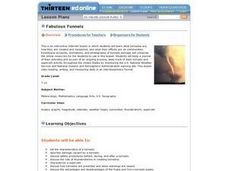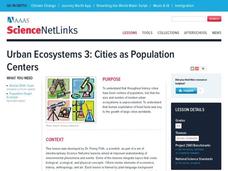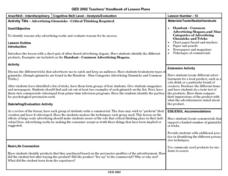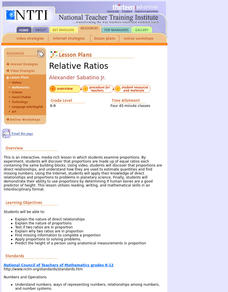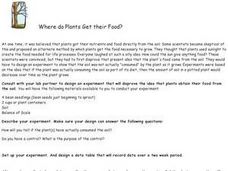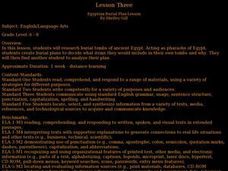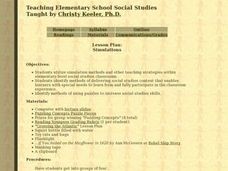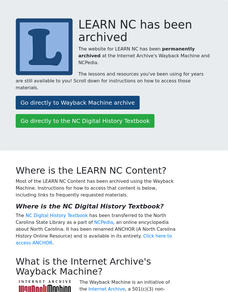Curated OER
Finding Science in An American Childhood by Annie Dillard
High schoolers read excerpts from Annie Dillard's memoir, "An American Childhood," with the teacher. They experience opportunities to connect English, science, nature and art together from a new and unique perspective. This approach...
Curated OER
Fabulous Funnels
Students explore what tornados are, how they are created and measured, and what their effects are on communities. They keep a journal of their activities and explorations as part of an ongoing process of learning.
Curated OER
Urban Ecosystems 3: Cities as Population Centers
Students discover that throughout history cities have been centers of population but that human exploitation of fossil fuels was key to the growth of large cities worldwide. They research urban growth through a number of websites.
Curated OER
Pennsylvania Colony
Students research the main reasons for the colonists moving to the Pennsylvania colony. They analyze maps, label a bubble map, list similarities/differences of immigrants then and now, and create a colonial newspaper advertisement.
Curated OER
Infrared-Hot
Students describe how the sun heats the Earth, explain the nature of infrared light, explain how thunderstorms are formed and use infrared maps to predict severe weather.
Curated OER
Let's Get Moving
Students participate in sports activities that relate to motion, velocity and momentum. They produce a PowerPoint presentation after researching the activities.
Curated OER
Advertising Gimmicks - Critical Thinking Required
Learners identify reasons why advertising works, evaluate reasons for its success, and write commercials.
Curated OER
Relative Ratios
Learners discover that proportions are made up of equal ratios each containing the same building blocks. They, using the Internet, apply their knowledge of direct relationships and proportions to problems in planetary science.
Curated OER
Picking Pythagoras
Students discover that side measurement is used in determining angle classification of a triangle. By squaring sides, they predict whether triangles be right, obtuse, or acute. They prove the Pythagorean Theorem and use it to solve...
Curated OER
Korean Table Manners
Students experience the proper table manners in Korea. They eat a Korean meal with proper table manners. Students then describe, list and demonstrate the proper Korean table manners. They compare and contrast the American table...
Curated OER
The High and the Flighty
Young scholars study women aviators and act out a talk show-style interview with one of them. They plot Amelia Earhart's flights on a map.
Curated OER
A New Slant On The Seasons
Students identify how the tilt and position of the Earth causes the seasons. After a discussion of the seasons and when they begin. Using themselves as the objects in the universe, they role play how the rotational movement of the...
Curated OER
Where Do Plants Get Their Food?
Plants need food to survive, just like any other living organism. Young biologists analyze an experiment performed in 1610 by Jan van Helmont to determine if plant nutrition is obtained through the soil. First, lab groups work together...
Curated OER
Amate Bark Paintings/Folk Arts of Latin America
Students explore the history of bark paintings in South America and produce their own version of these paintings.
Curated OER
Entertainment and Recreation in the Early Twentieth Century and Today
Eleventh graders research entertainment and recreation in the early twentieth century using primary sources and the book From the Hidewood, by Robert Amerson. They compare the rural experience of the time period to the national...
Curated OER
Egyptian Burial
Students research burial tombs of ancient Egypt. Acting as pharaohs of Egypt, students create burial plans to decide what items they would include in their own tombs and why. They find another student to analyze their plan.
Curated OER
Simulations
Students utilize simulation methods and other teaching strategies within elementary-level social studies classrooms. They identify methods of delivering social studies content that enables learners with special needs to learn from and...
Curated OER
A Photosynthesis Timeline
Science learners discover that scientific advancements come in increments. Beginning as an idea, changes and developments are influenced by available resources and current societal values. As an example, pupils examine the conclusions...
Curated OER
Cookie Topography
Students construct a cross section diagram showing elevation changes on a "cookie island." Using a chocolate chip cookie for an island, they locate the highest point in centimeters on the cookie and create a scale in feet. After tracing...
Curated OER
Community Treasures (Rivers and Trees): An Integrated Curriculum Unit
Third graders demonstrate an understanding of geography and its effects on lifestyles and culture. Then they apply basic economic terms and principles
and identify the United States government and history. Students also identify and...
Curated OER
A Picture's Worth 1000 Words: Decoding Intercultural Symbols
Learners interpret a set of pictographs, defining what each image means and create their own set of symbols as an alphabet. They then write using their own symbolic alphabet using pictures.
Curated OER
1900 America: Historical Voices, Poetic Visions
Pupils examine the United States at the turn of the century. Using primary source documents, they interpret them within a specific historical context. Using this information, they write a poem with metaphors and a specific meter They...
Curated OER
Jewelry: Then and Now
Fifth graders identify specific works of art as belonging to particular cultures, times, & places, recognize & apply elements of art, learn techniques for working with each material, critique artwork, & discuss how artwork...
Curated OER
Inventing and Presenting Unit 3: Persuasive Speaking and Invention Promotion
Students write a proposal for a speech. Students prepare appropriate visuals for use in the proposed speech. Students produce one or more graphs that summarize the results from the experimentation. Students deliver an effective speech in...

